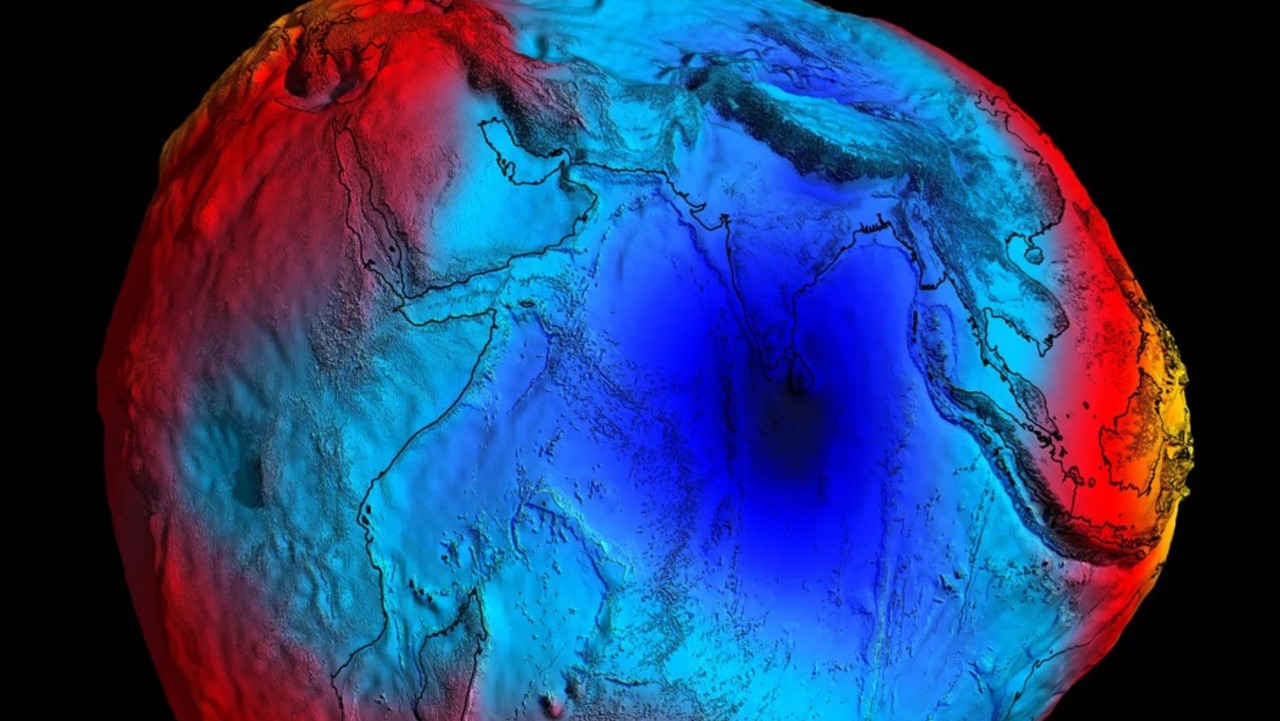Gravity hole in the Indian Ocean explained
A giant “hole” in the Indian Ocean has puzzled scientists since it was discovered, but now researchers have explained why it exists.
A giant, three million square-kilometre “hole” in the Indian Ocean has puzzled scientists since it was discovered, but now a group of researchers believe they know why it exists.
The “gravity hole” — a spot where Earth’s gravitational pull is weaker, its mass lower than normal and the sea level dips by more than 100 metres — was discovered by Dutch geophysicist Felix Andries Vening Meinesz in 1948 and has remained a mystery ever since.
Now researchers from the Indian Institute of Science in Bengaluru, India claim to have found a credible explanation for its formation: plumes of magma coming from deep inside the planet, much like those that lead to the creation of volcanoes.
The team used supercomputers to simulate how the perplexing hole may have formed, going back as far as 140 million years — well before humans walked the Earth.
Their findings, published in the Geophysical Research Letters journal, centre around an ancient ocean that no longer exists.

The disappearing ocean
People often think of the Earth as a perfect sphere, but that’s not actually the case.
“The Earth is basically a lumpy potato,” said study co-author Attreyee Ghosh, a geophysicist and associate professor at the Centre for Earth Sciences of the Indian Institute of Science.
“So technically it’s not a sphere, but what we call an ellipsoid, because as the planet rotates the middle part bulges outward.”
Some areas of our planet are also denser than others, which affects its surface and gravity.
“If you pour water on the surface of the Earth, the level that the water takes is called a geoid — and that is controlled by these density differences in the material inside the planet, because they attract the surface in very different ways depending on how much mass there is underneath,” Dr Ghosh explained.
The “gravity hole” in the Indian Ocean — officially called the Indian Ocean geoid low — is the lowest point in that geoid, forming a circular depression that starts just off India’s southern tip and spans three million square kilometres.
“It is by far the biggest low in the geoid, and it hasn’t been explained properly,” Dr Ghosh said.
Dr Ghosh and her team used computer models to demonstrate how the Earth would have looked across millions of years, including where oceans and continents were and its density structure.
They ran 19 simulations up to the present day, recreating the shifting of tectonic plates and the movement of magma in the mantle under Earth’s crust.
In six of the scenarios, a geoid low similar to the one in the Indian Ocean formed — and in all of those scenarios, plumes of magma were present around the geoid low.
It’s those plumes of magma, as well as the structure of the mantle in the vicinity, that the researchers believe are responsible for the formation of the “gravity hole”.
The plumes came from the disappearance of an ancient ocean, which vanished as India drifted and collided to become part of Asia tens of millions of years ago, Dr Ghosh said.
“India was in a very different place 140 million years ago, and there was an ocean between the Indian Plate and Asia,” she explained.
“India started moving north and as it did, the ocean disappeared and the gap with Asia closed. As the oceanic plate went down inside the mantle, it could have spurred the formation of the plumes, bringing low-density material closer to Earth’s surface.”

The future of the geoid low
The geoid low formed some 20 million years ago, according to the researchers’ calculation.
It’s unknown whether it will ever disappear or shift away.
“That all depends on how these mass anomalies in the Earth move around,” Dr Ghosh said.
“It could be that it persists for a very long time. But it could also be that the plate movements will act in such a way to make it disappear — a few hundreds of millions of years in the future.”
Originally published as Gravity hole in the Indian Ocean explained





